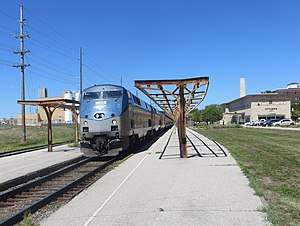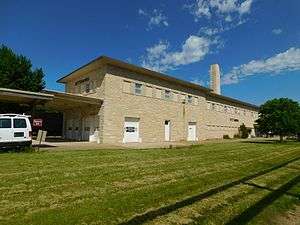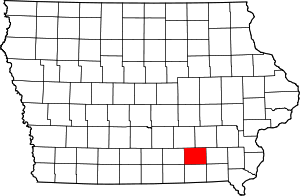Ottumwa station
Ottumwa is an Amtrak intercity train station in Ottumwa, Iowa, United States. The station was originally built by the Chicago, Burlington and Quincy Railroad, and has been listed as Burlington Depot by the National Register of Historic Places since November 26, 2008. It became a contributing property in the Historic Railroad District in 2011.
Ottumwa, IA | |||||||||||||||||||||||||||||||||||||||||||||||||||||||||||||||
|---|---|---|---|---|---|---|---|---|---|---|---|---|---|---|---|---|---|---|---|---|---|---|---|---|---|---|---|---|---|---|---|---|---|---|---|---|---|---|---|---|---|---|---|---|---|---|---|---|---|---|---|---|---|---|---|---|---|---|---|---|---|---|---|
 The eastbound California Zephyr at Ottumwa in August 2017 | |||||||||||||||||||||||||||||||||||||||||||||||||||||||||||||||
| Location | 210 West Main Street, Ottumwa, Iowa | ||||||||||||||||||||||||||||||||||||||||||||||||||||||||||||||
| Platforms | 1 side platform, 1 island platform | ||||||||||||||||||||||||||||||||||||||||||||||||||||||||||||||
| Tracks | 2 | ||||||||||||||||||||||||||||||||||||||||||||||||||||||||||||||
| Construction | |||||||||||||||||||||||||||||||||||||||||||||||||||||||||||||||
| Parking | Yes | ||||||||||||||||||||||||||||||||||||||||||||||||||||||||||||||
| Disabled access | Yes | ||||||||||||||||||||||||||||||||||||||||||||||||||||||||||||||
| Other information | |||||||||||||||||||||||||||||||||||||||||||||||||||||||||||||||
| Station code | OTM | ||||||||||||||||||||||||||||||||||||||||||||||||||||||||||||||
| History | |||||||||||||||||||||||||||||||||||||||||||||||||||||||||||||||
| Rebuilt | May 26, 1951[1] | ||||||||||||||||||||||||||||||||||||||||||||||||||||||||||||||
| Traffic | |||||||||||||||||||||||||||||||||||||||||||||||||||||||||||||||
| Passengers (2017) | 12,209[2] | ||||||||||||||||||||||||||||||||||||||||||||||||||||||||||||||
| Services | |||||||||||||||||||||||||||||||||||||||||||||||||||||||||||||||
| |||||||||||||||||||||||||||||||||||||||||||||||||||||||||||||||
| |||||||||||||||||||||||||||||||||||||||||||||||||||||||||||||||
Burlington Depot | |||||||||||||||||||||||||||||||||||||||||||||||||||||||||||||||
 The former Burlington depot, currently used by Amtrak. | |||||||||||||||||||||||||||||||||||||||||||||||||||||||||||||||
  | |||||||||||||||||||||||||||||||||||||||||||||||||||||||||||||||
| Coordinates | 41.0186°N 92.4149°W | ||||||||||||||||||||||||||||||||||||||||||||||||||||||||||||||
| Built | 1951 | ||||||||||||||||||||||||||||||||||||||||||||||||||||||||||||||
| Built by | Benson Const. Co. | ||||||||||||||||||||||||||||||||||||||||||||||||||||||||||||||
| Architect | Holabird, Root & Burgee | ||||||||||||||||||||||||||||||||||||||||||||||||||||||||||||||
| Architectural style | Modern Movement | ||||||||||||||||||||||||||||||||||||||||||||||||||||||||||||||
| Part of | Historic Railroad District (ID11000723) | ||||||||||||||||||||||||||||||||||||||||||||||||||||||||||||||
| NRHP reference No. | 08001100 | ||||||||||||||||||||||||||||||||||||||||||||||||||||||||||||||
| Added to NRHP | November 26, 2008[3] | ||||||||||||||||||||||||||||||||||||||||||||||||||||||||||||||
History
The Burlington and Missouri River Railroad (B&M) reached Ottumwa from Burlington, Iowa in 1859, and the city remained the western terminus for the line until after the American Civil War. In the summer of 1865 work began to extend the line west of Ottumwa and it reached the Missouri River four years later. The Chicago, Burlington and Quincy Railroad (CB&Q) invested heavily in the project and took over the B&M in 1875. The CB&Q built a combination passenger and freight depot in Ottumwa in 1889. Its design was attributed to the Chicago architectural firm of Burnham and Root, who designed all of the railroad's larger depots.[4] Ottumwa was the division point for the line. The CB&Q was one of five railroads that served the city, and it shared their depot with the Chicago, Rock Island and Pacific Railroad. This depot was known as Ottumwa Union Depot.[4] The Chicago, Milwaukee, St. Paul and Pacific Railroad (Milwaukee Road) and Wabash Railroad served Ottumwa at a depot at Jefferson Street, listed as about .25 miles (0.40 km) away from the current station.[5][6] The since-abandoned Milwaukee Road tracks were on a branch from its main line to Kansas City, which ran through Ottumwa on the northwest side of town. The Wabash Railroad tracks ended at Ottumwa, and crossed the Des Moines River on a bridge that has been repurposed into a trail.[7][8]
After World War II Ottumwa experienced a building boom, and the CB&Q decided to replace its depot with a modern one. The Chicago architectural firm of Holabird, Root & Burgee designed the new depot as well new depot in Burlington, Iowa in 1943. That depot was the standard used to design other CB&Q depots after the war with Ottumwa being one.[4] The new Ottumwa depot was completed in 1951 by Benson Construction Company using the limestone foundation of the old depot and its exterior walls. None of the old depot is visible today. During construction, the railroad used two passenger cars as ticket office and waiting room. Ballingall Park in front of the depot was completed at the same time. The present depot is a two-story structure designed in a simple Modernist style. The rectangular building features a flat roof, broad eaves banded windows, and an exterior clad with ashlar Lannon stone.
Local transit connections
The Ottumwa Transit Authority East-West Route stops near the station. However, under the current California Zephyr schedule, Emeryville-bound trains arrive almost an hour after the system ends its daily operations.
References
- "Ottumwa Dedicates Railroad Station and City Park". The Des Moines Register. May 27, 1951. p. 25. Retrieved July 1, 2019 – via Newspapers.com.

- "Amtrak Fact Sheet, FY2017, State of Iowa" (PDF). Amtrak. November 2017. Retrieved 12 January 2018.
- "National Register Information System". National Register of Historic Places. National Park Service. March 13, 2009.
- Molly Myers Naumann. "NRHP Inventory-Nomination: Burlington Depot". National Park Service. Retrieved 2019-03-27.
- Waterman, Harrison Lyman (1914). History of Wapello County, Iowa. 1. Wapello County: S. J. Clarke Publishing Company. p. 163. Retrieved April 9, 2020.
- "Index of Railroad Stations". Official Guide of the Railways. New York City: National Railway Publishing Company. June 1941. p. 1445.
- Carpenter, Richard C. (2013). "Ottumwa, IA". A Railroad Atlas of the United States in 1946: Volume 5: Iowa and Minnesota. JHU Press. p. 104A. Retrieved April 9, 2020.
- Newman, Mark (September 7, 2018). "Historic Wabash railroad society is coming to Ottumwa". Ottumwa Courier. Retrieved April 9, 2020.
